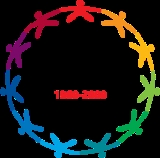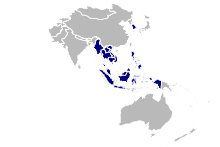
ASEAN-Republic of Korea Commemorative Summit
Encyclopedia
| ASEAN – Republic of Korea Commemorative Summit 2009 |
|---|
 |
The ASEAN – Republic of Korea Commemorative Summit is an international meeting which Republic of Korea
South Korea
The Republic of Korea , , is a sovereign state in East Asia, located on the southern portion of the Korean Peninsula. It is neighbored by the People's Republic of China to the west, Japan to the east, North Korea to the north, and the East China Sea and Republic of China to the south...
held to celebrate the 20th year anniversary of the ASEAN – Republic of Korea dialogue relations. The summit was held from 1 to 2 June 2009 in Jeju Island
Jeju-do
Jeju-do is the only special autonomous province of South Korea, situated on and coterminous with the country's largest island. Jeju-do lies in the Korea Strait, southwest of Jeollanam-do Province, of which it was a part before it became a separate province in 1946...
, Republic of Korea. The Heads of Government/State of each ASEAN member country, the President of Korea, and the Secretary General of ASEAN
Surin Pitsuwan
Surin Pitsuwan is a longtime Thai politician. He was born in Nakhon Si Thammarat, into an assimilated Thai family of Malay descent.-Early life:...
attended the summit.
The ASEAN – Korea CEO Summit, ASEAN – Korea Traditional Music Orchestra, and Green Growth Exhibition were held as special events at the International Convention Center Jeju (ICC Jeju) from 31 May to 2 June.
Other culture and tourism events were held in different parts of Jeju Island throughout the duration of the summmit.
Background
The ASEAN-Republic of Korea Commemorative Summit was held as 2009 marks the 20th anniversary of the ASEAN-Republic of Korea Dialogue Relationship. The Leaders of the 11 countries discussed the developments of cooperative relations between Korea and the countries in the ASEAN region for the past 20 years, and also examined future directions for progress. Methods to overcome global issues that the international society faces, such as the financial crisis and climate change, were also discussed.The summit was another move for Korea to put the “New Asia Diplomacy Plan” into action, strengthen Korea’s collaborative relations with the Southeast Asian region and expand Korea’s diplomatic relations.
Program at a Glance
| 31 May (Sun) | 1 June (Mon) | 2 June (Tue) |
|---|---|---|
|
|
|
Participants
Participants for the Summit are:- HOS/Gs of all ASEAN countries and Republic of Korea (See the information box for a detail)
- The Secretary General of ASEAN
- Ministers
- Official Media
- Embassy Staffs
- Other Delegates
- CEOs (to participate in ASEAN-Korea CEO Summit)
The total number of participants is expected to be over 7,000.
Logo/Catchphrase
The logo symbolizes the core message of the Summit, namely, "neighborhood filled with warmth" and "partnership for common prosperity", through the image of eleven people holding hands, and embodies a desire to further promote the relationship.The rainbow gradation represents the uniqueness of each country bound together in harmony, and suggests a bright future for ASEAN-Republic of Korea relations.
The catchphrase "Partnership for Real, Friendship for Good" symbolizes the policies of the ASEAN, which pursue tighter relations between Republic of Korea and ASEAN countries, and aim to share closer friendship through more frequent cultural and individual exchanges.
Venue
The main venue of the Summit was the International Convention Center Jeju (ICC Jeju) located at Jungmun, Seogwipo, Jeju. It features a resort-style convention center and often used for international conventions, banquets, sport events, etc. Major events of the Summit were held at ICC Jeju.Commemorative Summit Sessions
There were two Commemorative Summit sessions, session 1 on June 1 and session 2 on June 2. Each session was participated by HOS/Gs of all ASEAN countries, the president of Republic of Korea and the Secretriat General of ASEAN.Each session had different agendas to cover. Session 1 covers agendas such as "Evaluation of cooperative relationship between Korea and ASEAN" and "Direction of developments in politics, national security, economy, society and culture". Session 2 covered "Ways to strengthen the cooperative strategy of worldwide issues such as global financial crisis, energy security and climatic change."
Leaders of Korea and the ten ASEAN member countries signed a joint statement composed of 40 clauses in five sections at the end of the summit.

